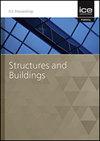Non-linear analysis of CFRP-wrapped steel box sections under biaxial load
IF 1.4
4区 工程技术
Q3 CONSTRUCTION & BUILDING TECHNOLOGY
Proceedings of the Institution of Civil Engineers-Structures and Buildings
Pub Date : 2023-06-27
DOI:10.1680/jstbu.22.00161
引用次数: 0
Abstract
The effect of biaxial compressive loading on hollow steel box column (HSBC) and concrete-filled steel box column (CFSBC) sections wrapped with low-modulus carbon-fibre-reinforced polymer (CFRP) was studied. The CFSBC and HSBC sections were simulated using Abaqus finite-element software and validated using available experimental data. Biaxial compressive loading was considered for different eccentricities (i.e. eccentricity to depth ratio (e/D) ratio of zero to 0.32). The results indicated that, for CFRP-wrapped HSBCs at low eccentricity (e/D = 0.08), compact and non-compact sections were effective at carrying higher load, while a slender section was effective for concentric loads. For the CFRP-wrapped CFSBCs, compact and non-compact sections were effective for all the eccentric loads (e/D = 0–0.32). It was also found that the low-modulus CFRP layer wrapping the CFSBC sections had no significant effect on strength. An empirical relationship was developed based on trend analysis, which gives the load-carrying capacity of any section. For the CFSBC sections, axial compression–uniaxial moment (P–M) interaction curves are presented to validate the simulation results under biaxial loading.双轴荷载作用下cfrp包钢箱梁截面非线性分析
研究了双轴压缩荷载对低模量碳纤维增强聚合物(CFRP)包裹的空心钢箱柱(HSBC)和钢箱混凝土柱(CFSBC)截面的影响。利用Abaqus有限元软件对CFSBC和HSBC剖面进行了模拟,并利用已有的实验数据进行了验证。考虑不同偏心率(即偏心率与深度比(e/D)为0 ~ 0.32)时的双轴压缩载荷。结果表明,对于低偏心(e/D = 0.08) cfrp包裹的hsbc,紧凑和非紧凑截面能有效承受较大载荷,而细长截面能有效承受同心载荷。对于cfrp包裹的cfsbc,紧凑和非紧凑截面对所有偏心荷载都有效(e/D = 0-0.32)。低模量CFRP层包裹CFSBC截面对强度无显著影响。在趋势分析的基础上建立了经验关系,给出了任意截面的承载能力。针对CFSBC截面,给出了轴向压缩-单轴弯矩相互作用曲线,验证了双轴加载下的模拟结果。
本文章由计算机程序翻译,如有差异,请以英文原文为准。
求助全文
约1分钟内获得全文
求助全文
来源期刊
CiteScore
3.40
自引率
6.20%
发文量
61
审稿时长
12 months
期刊介绍:
Structures and Buildings publishes peer-reviewed papers on the design and construction of civil engineering structures and the applied research associated with such activities. Topics include the design, strength, durability and behaviour of structural components and systems.
Topics covered: energy conservation, people movement within and around buildings, strength and durability of steel and concrete structural components, and the behaviour of building and bridge components and systems

 求助内容:
求助内容: 应助结果提醒方式:
应助结果提醒方式:


